Efficient Degradation of High-Molecular-Weight Hyaluronic Acid by a Combination of Ultrasound, Hydrogen Peroxide, and Copper Ion
Abstract
1. Introduction
2. Results and Discussion
2.1. Effects of Different Degradation Conditions
2.1.1. Effects of Hydrogen Peroxide Concentration on HA Degradation
2.1.2. Effects of Copper Ion Concentration on HA Degradation
2.1.3. Effects of pH on HA Degradation
2.1.4. Effects of Temperature on HA Degradation
2.1.5. Effects of Ultrasonic Power on HA Degradation
2.1.6. Comparison of Degradation Efficiency of Hyaluronic Acid under Different Conditions
2.2. Structural Analysis of LMW-HA
2.2.1. Content of Glucuronic Acid in LMW-HA
2.2.2. FTIR Spectra of HA and LMW-HA
2.2.3. CD Spectrum of HA and LMW-HA
2.2.4. UV–VIS Absorption Spectra
3. Materials and Methods
3.1. Materials
3.2. Analytical Methods
3.3. Degradation Studies
3.3.1. Effect of Hydrogen Peroxide Concentration
3.3.2. Effect of CuCl2 Content
3.3.3. Effect of pH
3.3.4. Effect of Temperature
3.3.5. Effect of Ultrasonic Power
3.3.6. Comparison of Degradation Efficiency of HMW-HA under Different Conditions
4. Conclusions
Author Contributions
Funding
Conflicts of Interest
References
- Chang, B.; Ahuja, N.; Ma, C.; Liu, X. Injectable scaffolds: Preparation and application in dental and craniofacial regeneration. Mat. Sci. Eng. R 2017, 111, 1–26. [Google Scholar] [CrossRef] [PubMed]
- Chen, W.Y.; Abatangelo, G. Functions of hyaluronan in wound repair. Wound Repair Regen. 1999, 7, 79–89. [Google Scholar] [CrossRef] [PubMed]
- Kakehi, K.; Kinoshita, M.; Yasueda, S. Hyaluronic acid: Separation and biological implications. J. Chromatogr. B 2003, 797, 347–355. [Google Scholar] [CrossRef]
- Inoue, M.; Katakami, C. The effect of hyaluronic acid on corneal epithelial cell proliferation. Invest. Ophth. Vis. Sci. 1993, 34, 2313–2315. [Google Scholar]
- Mast, B.A.; Frantz, F.W.; Diegelmann, R.F.; Krummel, T.M.; Cohen, I.K. Hyaluronic acid degradation products induce neovascularization and fibroplasia in fetal rabbit wounds. Wound Repair Regen. 1995, 3, 66–72. [Google Scholar] [CrossRef] [PubMed]
- D’Agostino, A.; Stellavato, A.; Corsuto, L.; Diana, P.; Filosa, R.; La Gatta, A.; De Rosa, M.; Schiraldi, C. Is molecular size a discriminating factor in hyaluronan interaction with human cells? Carbohyd. Polym. 2017, 157, 21–30. [Google Scholar] [CrossRef]
- Miyazaki, T.; Yomota, C.; Okada, S. Ultrasonic depolymerization of hyaluronic acid. Polym. Degrad. Stabil. 2001, 74, 77–85. [Google Scholar] [CrossRef]
- Jeanloz, R.W.; Jeanloz, D.A. The Degradation of Hyaluronic Acid by Methanolysis. Biochemistry 1964, 3, 121–122. [Google Scholar] [CrossRef]
- Holubova, L.; Korecka, L.; Podzimek, S.; Moravcova, V.; Rotkova, J.; Ehlova, T.; Velebny, V.; Bilkova, Z. Enhanced multiparametric hyaluronan degradation for production of molar-mass-defined fragments. Carbohyd. Polym. 2014, 112, 271–276. [Google Scholar] [CrossRef]
- Melander, C.; Tommeraas, K. Heterogeneous hydrolysis of hyaluronic acid in ethanolic HCl slurry. Carbohyd. Polym. 2010, 82, 874–879. [Google Scholar] [CrossRef]
- Whistler, R.L.; Bemiller, J.N. Alkaline degradation of polysaccharides. Adv. Carbohyd. Chem. 1958, 13, 289–329. [Google Scholar]
- Soltes, L.; Stankovska, M.; Kogan, G.; Mendichi, R.; Volpi, N.; Sasinkova, V.; Gemeiner, P. Degradation of high-molar-mass hyaluronan by an oxidative system comprising ascorbate, Cu(II), and hydrogen peroxide: Inhibitory action of antiinflammatory drugs—Naproxen and acetylsalicylic acid. J. Pharmaceut. Biomed. 2007, 44, 1056–1063. [Google Scholar] [CrossRef] [PubMed]
- Soltes, L.; Brezova, V.; Stankovska, M.; Kogan, G.; Gemeiner, P. Degradation of high-molecular-weight hyaluronan by hydrogen peroxide in the presence of cupric ions. Carbohyd. Res. 2006, 341, 639–644. [Google Scholar] [CrossRef] [PubMed]
- Hafsa, J.; Chaouch, M.A.; Charfeddine, B.; Rihouey, C.; Limem, K.; Le Cerf, D.; Rouatbi, S.; Majdoub, H. Effect of ultrasonic degradation of hyaluronic acid extracted from rooster comb on antioxidant and antiglycation activities. Pharm. Biol. 2017, 55, 156–163. [Google Scholar] [CrossRef] [PubMed]
- Chang, K.L.; Tai, M.C.; Cheng, F.H. Kinetics and products of the degradation of chitosan by hydrogen peroxide. J. Agr. Food Chem. 2001, 49, 4845–4851. [Google Scholar] [CrossRef]
- Haber, F.; Weiss, J. The catalytic decomposition of hydrogen peroxide by iron salts. Proc. R. Soc. Lond. A 1934, 147, 332–351. [Google Scholar]
- Suslick, K.S.; Didenko, Y.; Fang, M.M.; Hyeon, T.; Kolbeck, K.J.; McNamara, W.B.; Mdleleni, M.M.; Wong, M. Acoustic cavitation and its chemical consequences. Phil. Trans. R. Soc. A 1999, 357, 335–353. [Google Scholar] [CrossRef]
- Mehrdad, A.; Hashemzadeh, R. Ultrasonic degradation of Rhodamine B in the presence of hydrogen peroxide and some metal oxide. Ultrason. Sonochem. 2010, 17, 168–172. [Google Scholar] [CrossRef]
- Chen, S.J.; Chen, H.; Gao, R.C.; Li, L.H.; Yang, X.Q.; Wu, Y.Y.; Hu, X. Degradation of hyaluronic acid derived from tilapia eyeballs by a combinatorial method of microwave, hydrogen peroxide, and ascorbic acid. Polym. Degrad. Stabil. 2015, 112, 117–121. [Google Scholar] [CrossRef]
- Gilli, R.; Kacurakova, M.; Mathlouthi, M.; Navarini, L.; Paoletti, S. FTIR studies of sodium hyaluronate and its oligomers in the amorphous solid phase and in aqueous solution. Carbohyd. Res. 1994, 263, 315–326. [Google Scholar] [CrossRef]
- Staskus, P.W.; Johnson, W.C. Conformational Transition of Hyaluronic Acid in Aqueous-Organic Solvent Monitored by Vacuum Ultraviolet Circular Dichroism. Biochemistry 1988, 27, 1522–1527. [Google Scholar] [CrossRef] [PubMed]
- Wu, Y. Preparation of low-molecular-weight hyaluronic acid by ozone treatment. Carbohyd. Polym. 2012, 89, 709–712. [Google Scholar] [CrossRef] [PubMed]
- Soltes, L.; Kogan, G.; Stankovska, M.; Mendichi, R.; Rychly, J.; Schiller, J.; Gemeiner, P. Degradation of high-molar-mass hyaluronan and characterization of fragments. Biomacromolecules 2007, 8, 2697–2705. [Google Scholar] [CrossRef] [PubMed]
- Bitter, T.; Muir, H.M. A modified uronic acid carbazole reaction. Anal. Biochem. 1962, 4, 330–334. [Google Scholar] [CrossRef]
Sample Availability: Samples of the compounds are not available from the authors. |
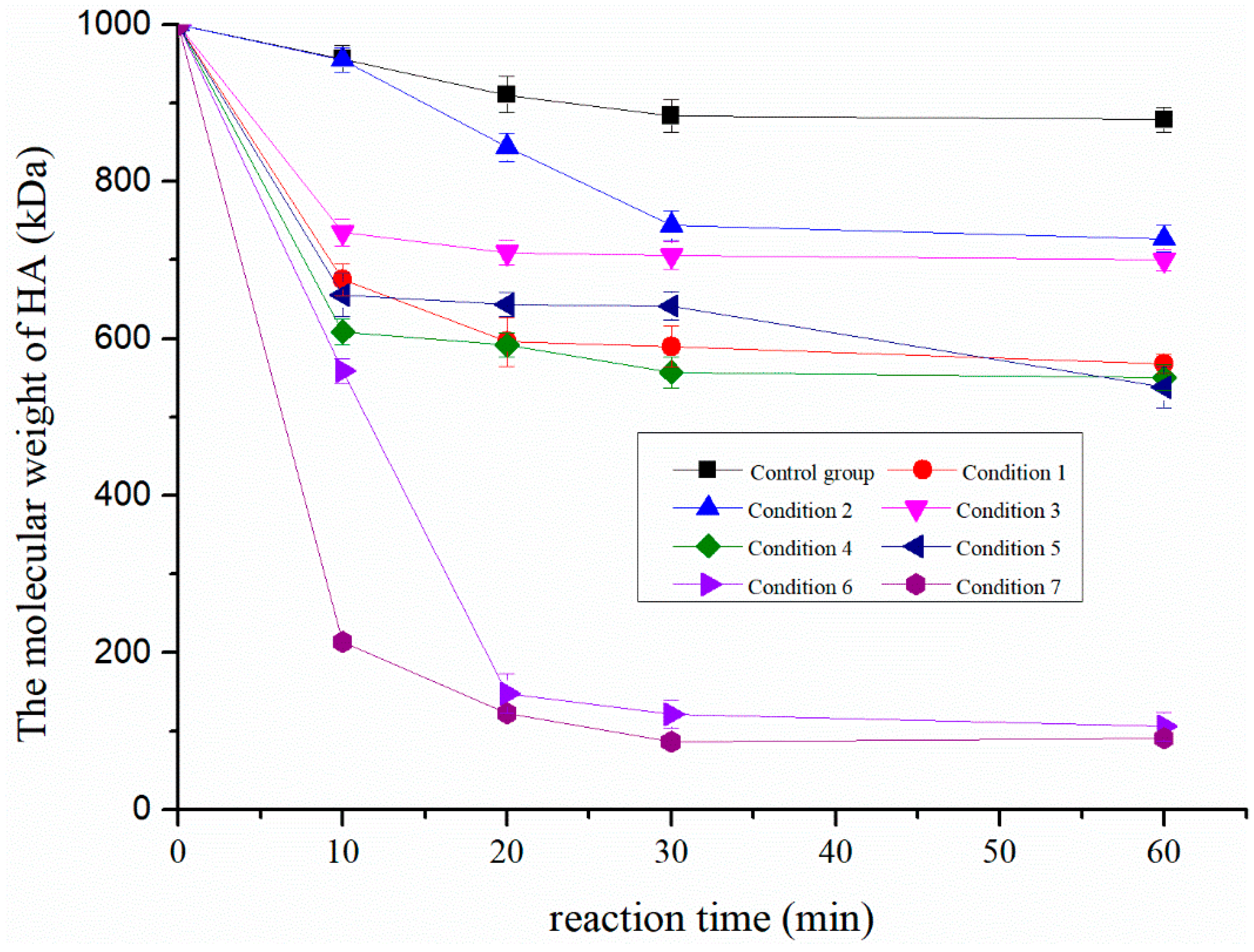
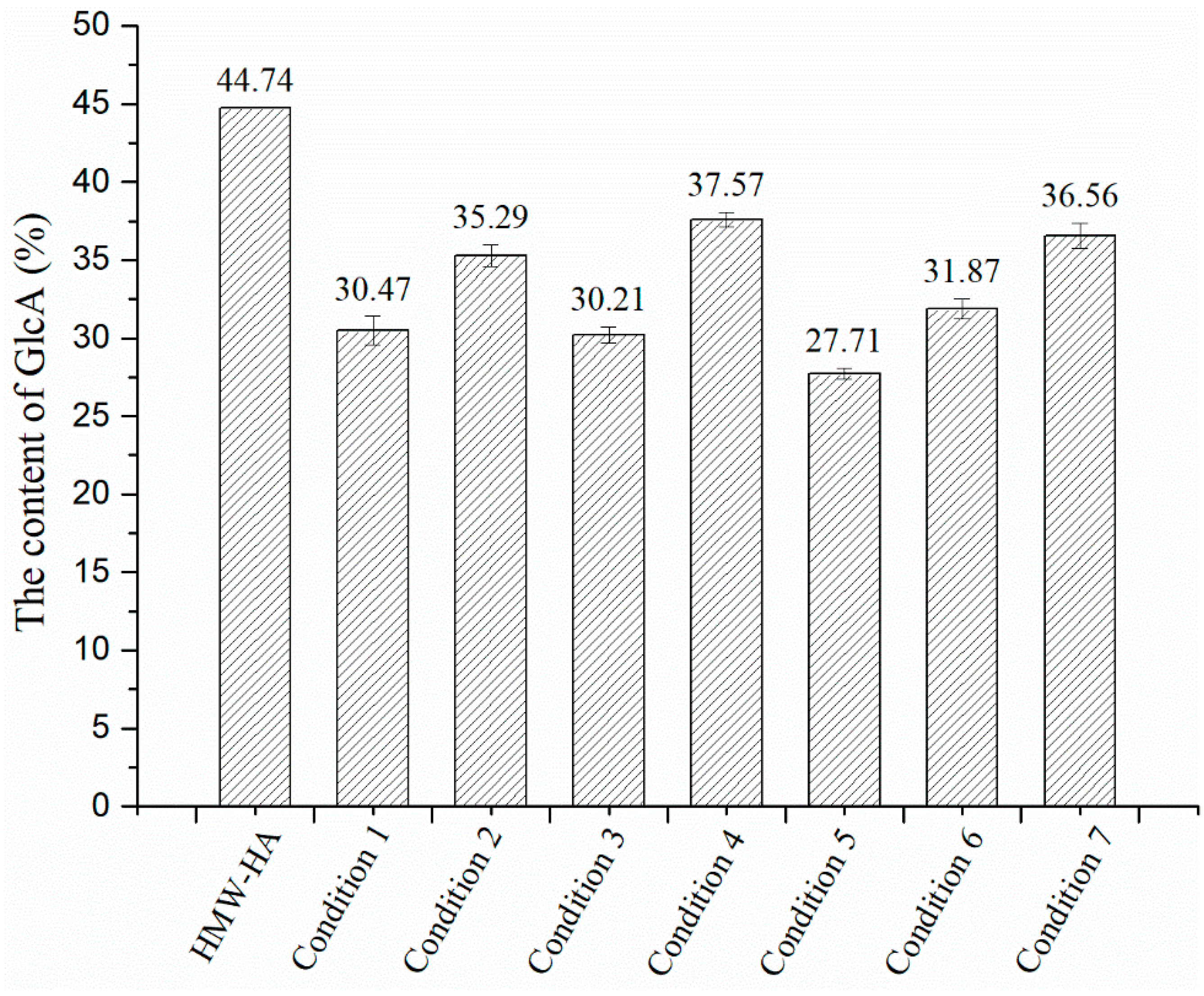
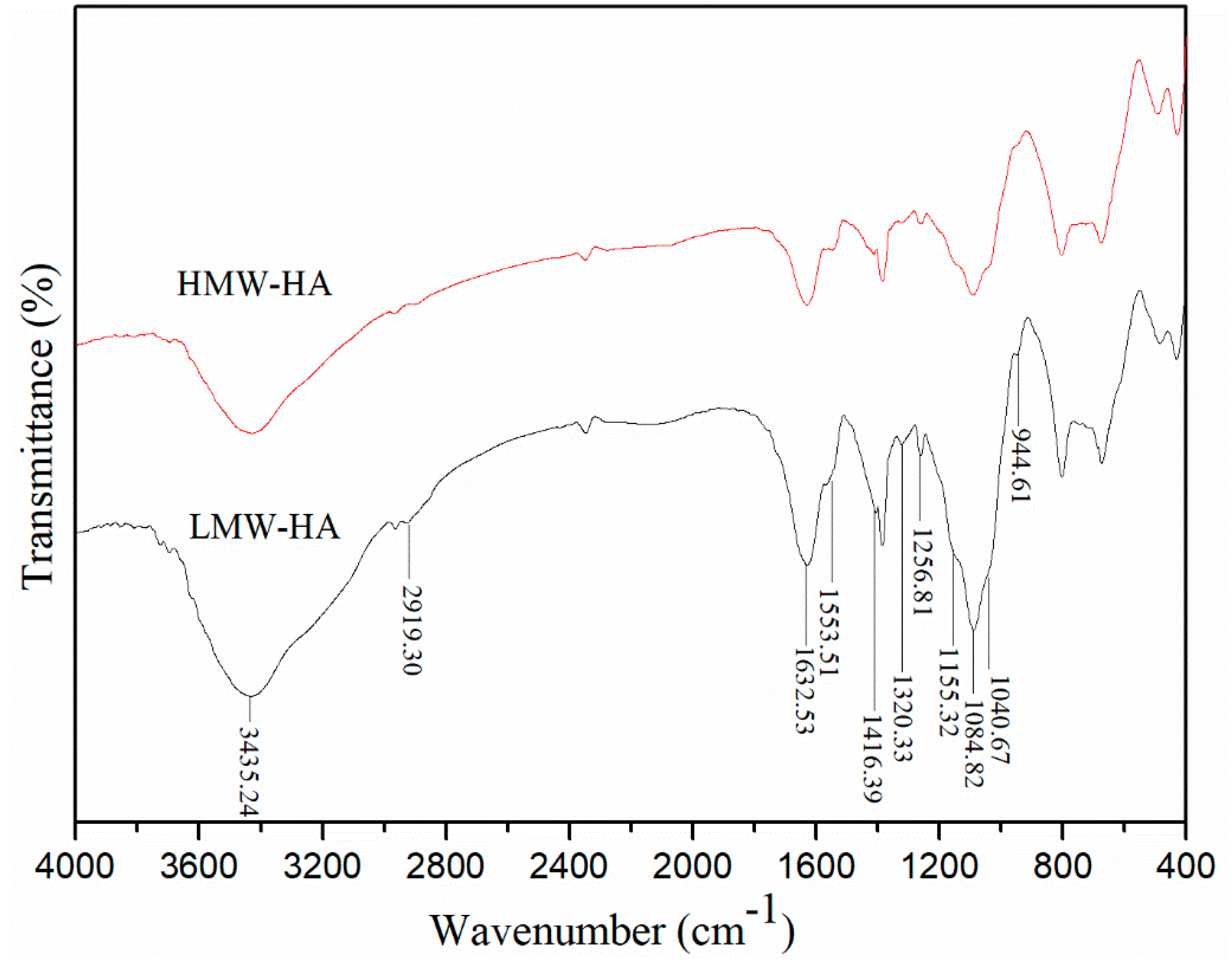
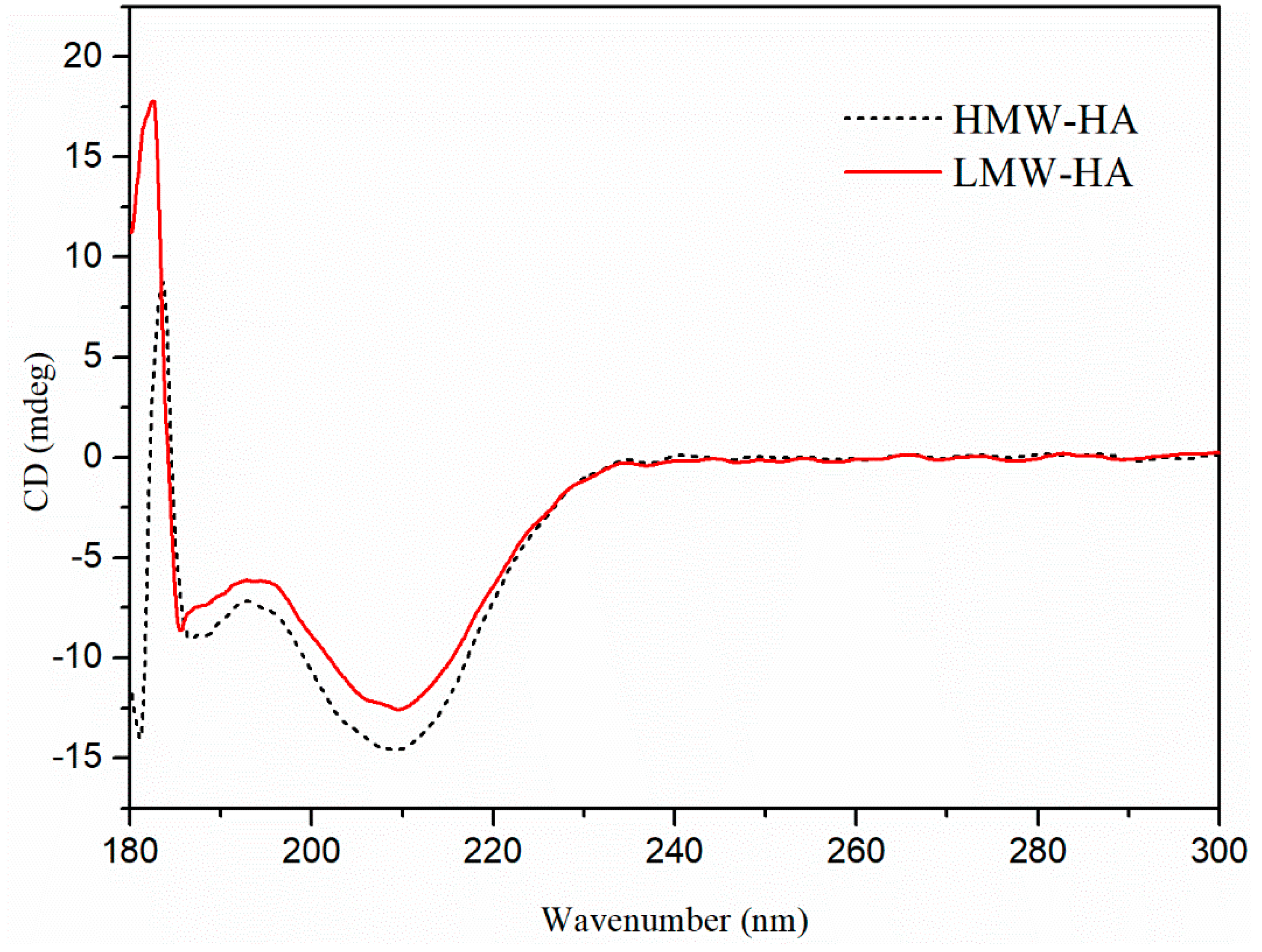
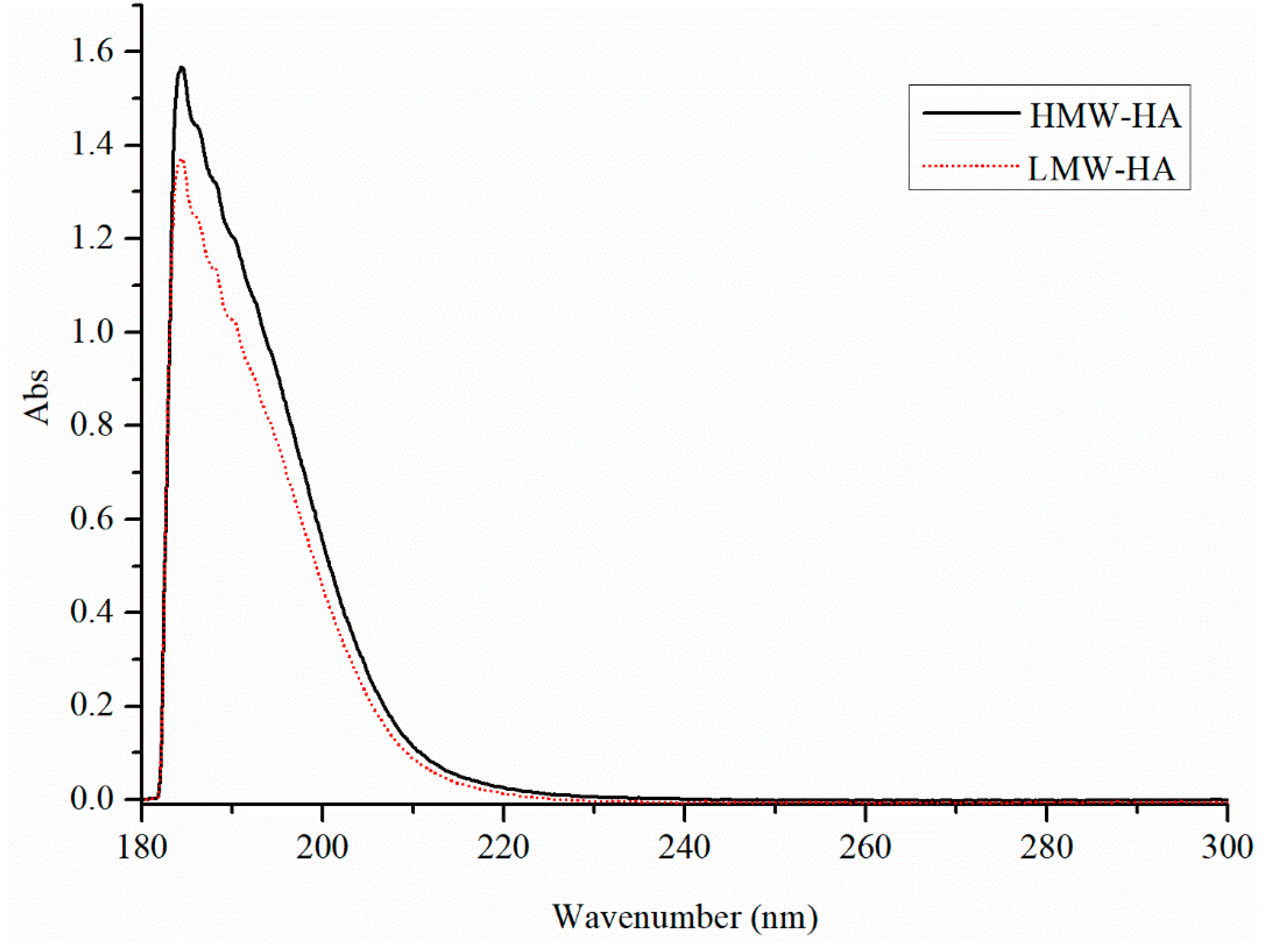
| Entry | Hydrogen Peroxide Concentration (mM) | Mn (kDa) | Mw (kDa) | Mw/Mn |
|---|---|---|---|---|
| 1 | 10 | 560.1 | 619.3 | 1.106 |
| 2 | 20 | 501.8 | 533.2 | 1.063 |
| 3 | 30 | 508.7 | 544.3 | 1.07 |
| 4 | 40 | 431.6 | 464.6 | 1.076 |
| 5 | 50 | 414.2 | 446.5 | 1.078 |
| 6 | 60 | 472.2 | 507.2 | 1.074 |
| Entry | CuCl2 Concentration (μM) | Mn (kDa) | Mw (kDa) | Mw/Mn |
|---|---|---|---|---|
| 1 | 0.1 | 413.2 | 449.3 | 1.087 |
| 2 | 1.0 | 374.6 | 405.3 | 1.082 |
| 3 | 2.0 | 311.5 | 348.6 | 1.119 |
| 4 | 3.0 | 206.4 | 256.9 | 1.245 |
| 5 | 4.0 | 86.06 | 123.5 | 1.435 |
| 6 | 5.0 | 87.58 | 111.5 | 1.273 |
| 7 | 6.0 | 83.47 | 112.8 | 1.351 |
| Entry | pH | Mn (kDa) | Mw (kDa) | Mw/Mn |
|---|---|---|---|---|
| 1 | 3 | 82.71 | 126.3 | 1.527 |
| 2 | 4 | 72.46 | 102.3 | 1.412 |
| 3 | 6 | 90.17 | 118.0 | 1.309 |
| 4 | 8 | 248.8 | 374.6 | 1.506 |
| 5 | 10 | 220.0 | 322.9 | 1.468 |
| Entry | Temperature (°C) | Mn (kDa) | Mw (kDa) | Mw/Mn |
|---|---|---|---|---|
| 1 | 20 | 65.74 | 101.2 | 1.539 |
| 2 | 30 | 85.56 | 120.4 | 1.407 |
| 3 | 40 | 70.89 | 110.6 | 1.560 |
| 4 | 50 | 47.98 | 71.70 | 1.494 |
| 5 | 60 | 45.35 | 68.05 | 1.500 |
| Entry | Ultrasonic Power (W) | Mn (kDa) | Mw (kDa) | Mw/Mn |
|---|---|---|---|---|
| 1 | 135 | 91.11 | 122.1 | 1.340 |
| 2 | 150 | 80.34 | 108.7 | 1.353 |
| 3 | 160 | 51.67 | 74.9 | 1.449 |
| 4 | 200 | 81.84 | 114.6 | 1.400 |
© 2019 by the authors. Licensee MDPI, Basel, Switzerland. This article is an open access article distributed under the terms and conditions of the Creative Commons Attribution (CC BY) license (http://creativecommons.org/licenses/by/4.0/).
Share and Cite
Chen, H.; Qin, J.; Hu, Y. Efficient Degradation of High-Molecular-Weight Hyaluronic Acid by a Combination of Ultrasound, Hydrogen Peroxide, and Copper Ion. Molecules 2019, 24, 617. https://doi.org/10.3390/molecules24030617
Chen H, Qin J, Hu Y. Efficient Degradation of High-Molecular-Weight Hyaluronic Acid by a Combination of Ultrasound, Hydrogen Peroxide, and Copper Ion. Molecules. 2019; 24(3):617. https://doi.org/10.3390/molecules24030617
Chicago/Turabian StyleChen, Hongyue, Jing Qin, and Yi Hu. 2019. "Efficient Degradation of High-Molecular-Weight Hyaluronic Acid by a Combination of Ultrasound, Hydrogen Peroxide, and Copper Ion" Molecules 24, no. 3: 617. https://doi.org/10.3390/molecules24030617
APA StyleChen, H., Qin, J., & Hu, Y. (2019). Efficient Degradation of High-Molecular-Weight Hyaluronic Acid by a Combination of Ultrasound, Hydrogen Peroxide, and Copper Ion. Molecules, 24(3), 617. https://doi.org/10.3390/molecules24030617





